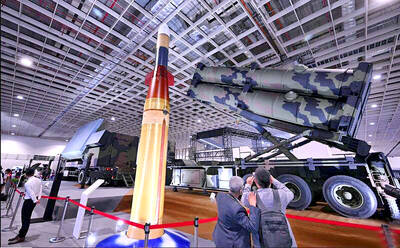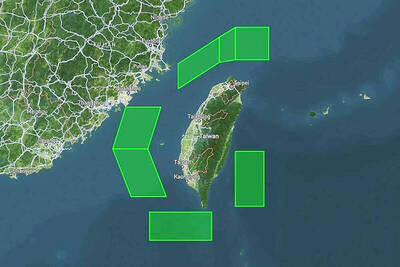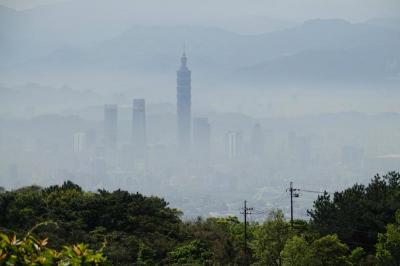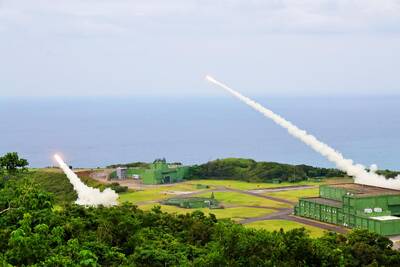As Beijing locks horns with a number of countries over the islands and waters of the East and South China Sea, China has launched a program to greatly increase its remote-sensing capabilities through the use of unmanned aerial vehicles (UAV), reports said yesterday.
The State Council last year approved a 10-year “national marine zoning” program to establish integrated, three dimensional, high-precision monitoring of China’s maritime areas. As part of China’s 12th five-year plan, which runs through to 2015, the State Oceanic Administration has been ordered to increase its remote-sensing capabilities through the acquisition and deployment of UAVs, pilot training and the construction of support infrastructure, Xinhua news agency reported.
In addition to increased surveillance of coastal waters, the UAVs are to also monitor waters under Chinese jurisdiction — including the Scarborough Shoal (Huangyan Island, 黃岩島), the Paracel Islannds (Xisha Islands, 西沙群島) and the Spratly (Nansha Islands, 南沙群島) archipelago in the South China Sea — over which China has engaged in territorial disputes with a number of neighboring states including Taiwan, Vietnam and the Philippines.
According to the report, the UAVs are also to be used to conduct surveillance near the Diaoyutai Islands (釣魚台) in the East China Sea — the object of an escalating dispute since Sept. 11 after the Japanese government announced the purchase of three of the islets comprising the potentially resource-rich archipelago. Taiwan, Japan and China all claim sovereignty over the islets.
Although China already uses space-based sensors to monitor its waters, UAVs provide much greater mobility and precision (down to 0.1m), and can loiter over a targeted area providing constant and real-time imaging. This is a major advantage over space orbiters, which, because of their altitude can only scan the same location every two or three days, thus minimizing the effective monitoring of fixed and moving targets.
At present, China relies mostly on satellites and manned aircraft to conduct maritime surveillance.
Japanese media reported last month that the US had agreed to use some of its Northrop Grumman RQ-4 Global Hawk drones — deployed at Andersen Air Force Base on Guam since September 2010 — to conduct surveillance over parts of Japanese territory and near the Diaoyutais, known as the Senkakus in Japan.
In recent years the Chinese military as well as law enforcement agencies have acquired and developed a number of unmanned vehicles, including fixed-wing aircraft and helicopters. The People’s Liberation Army Navy, and civilian maritime safety agencies, have also worked to actively integrate ship-based UAVs to their operations.
In related news, images released by Xinhua on Saturday indicated that J-10B and Sukhoi Su-30 all-weather combat aircraft had been dispatched to augment forces operating in the East China Sea Fleet.
This development occurs as the East China Sea Fleet held a tri-service landing drill which involved land, navy and air forces that simulated a landing attack. Dozens of landing ships took part in the exercise, with forces breaking rival army blockades and transporting troops to a landing area.

Taiwan is to commence mass production of the Tien Kung (天弓, “Sky Bow”) III, IV and V missiles by the second quarter of this year if the legislature approves the government’s NT$1.25 trillion (US$39.78 billion) special defense budget, an official said yesterday. Commenting on condition of anonymity, a defense official with knowledge of the matter said that the advanced systems are expected to provide crucial capabilities against ballistic and cruise missiles for the proposed “T-Dome,” an advanced, multi-layered air defense network. The Tien Kung III is an air defense missile with a maximum interception altitude of 35km. The Tien Kung IV and V

The disruption of 941 flights in and out of Taiwan due to China’s large-scale military exercises was no accident, but rather the result of a “quasi-blockade” used to simulate creating the air and sea routes needed for an amphibious landing, a military expert said. The disruptions occurred on Tuesday and lasted about 10 hours as China conducted live-fire drills in the Taiwan Strait. The Civil Aviation Administration (CAA) said the exercises affected 857 international flights and 84 domestic flights, affecting more than 100,000 travelers. Su Tzu-yun (蘇紫雲), a research fellow at the government-sponsored Institute for National Defense and Security Research, said the air

A strong continental cold air mass is to bring pollutants to Taiwan from tomorrow, the Ministry of Environment said today, as it issued an “orange” air quality alert for most of the country. All of Taiwan except for Hualien and Taitung counties is to be under an “orange” air quality alert tomorrow, indicating air quality that is unhealthy for sensitive groups. In China, areas from Shandong to Shanghai have been enveloped in haze since Saturday, the ministry said in a news release. Yesterday, hourly concentrations of PM2.5 in these areas ranged from 65 to 160 micrograms per cubic meter (mg/m³), and pollutants were

Taiwan lacks effective and cost-efficient armaments to intercept rockets, making the planned “T-Dome” interception system necessary, two experts said on Tuesday. The concerns were raised after China’s military fired two waves of rockets during live-fire drills around Taiwan on Tuesday, part of two-day exercises code-named “Justice Mission 2025.” The first wave involved 17 rockets launched at 9am from Pingtan in China’s Fujian Province, according to Lieutenant General Hsieh Jih-sheng (謝日升) of the Office of the Deputy Chief of the General Staff for Intelligence at the Ministry of National Defense. Those rockets landed 70 nautical miles (129.6km) northeast of Keelung without flying over Taiwan,